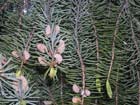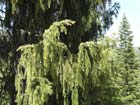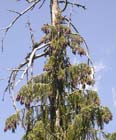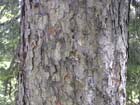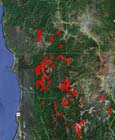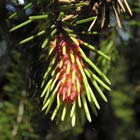Picea breweriana
S. Watson 1885
Common names
Weeping spruce, Brewer's spruce (Peattie 1950).
Taxonomic notes
Syn: P. brewerana [orth. var.].
P. breweriana is sympatric with Picea engelmannii at one location, on the slopes of Russian Peak (Sawyer and Thornburgh, 1969, 1970, cited by Ledig et al. 2005). It does not occur particularly close to Picea sitchensis; at their closest approach, populations are separated by 18.5 km and several hundred meters of elevation (Waring et al. 1975, cited by Ledig et al. 2005). No hybrids with either P. engelmannii or P. sitchensis have been observed in habitat (Sawyer and Thornburgh 1969, cited by Ledig et al. 2005), and repeated attempts at controlled pollination have failed to produce hybrids between P. breweriana and other spruces (Gordon 1986, cited by Ledig et al. 2005). Phylogenies based on molecular markers suggest that P. breweriana may stand alone in the genus with no close relatives (sources in Ledig et al. 2005).
A 2006 analysis of both paternal and maternal molecular markers (chloroplast and mitochondrial DNA) of over 30 species of Picea indicated that Picea breweriana and P. sitchensis are basal to Picea, with the other species in the genus divisible into three clades derived from two episodes of dispersal to Eurasia via the Beringian land bridge (Ran et al. 2006). Thus Picea appears to have originated in North America, with Picea breweriana as its most ancient species.
Description
Trees to 40 m tall and 200 cm dbh with a narrowly pyramidal crown, becoming columnar-conical with age. Branches initially upswept, later horizontal or sigmoid. Bark gray to brown. The foliar unit is a shoot, pendent, 30-100 cm long on mature trees, with foliage up to 4 years old; twigs ca. 2 mm diameter in first year, golden brown fading in a few years to gray-brown``, finely pubescent. Buds gray-brown, 5-7 mm, apex rounded. Leaves 1.5-3 cm long, spirally inserted on twig, flattened or broadly triangular in cross section (abaxial surface rounded or slightly angular), stiff, abaxial surface dark green, lacking stomatal bands, adaxial surface glaucous with conspicuous stomatal bands separated by slight ridge or angle, apex blunt. Seed cones dark red-purple ripening red-brown, cylindrical, 6.5-12 (-14) cm; scales fan-shaped, 15-20 × 15-20 mm, rigid, margin at apex entire to slightly erose (Taylor 1993, and my observations of specimens in habitat).
The twig is initially golden brown, in the second and later years fading to a darker gray-brown, after about 5 years developing bark, initially light gray and scaly with the bases of fallen leaves, which are lost after about 2 more years. By the time branches are 5 cm diameter the bark is scaly, flaky, the flakes eventually 3-5 cm across (even on the largest trees) and not imbricate. Seed cones borne in the upper crown; they develop, mature, set seed, and fall within about one year (my field notes, 2012).
Distribution and Ecology
USA: SW Oregon and NW California at (530-)1000-2300 m in montane to subalpine forests of the Siskiyou Mountains (Waring et al. 1975). See map at right. The species is distributed from 22 to 145 km from the coast, in scattered populations, of which the northernmost, at Iron Mountain, is disjunct by 29 km (Ledig et al. 2005).
Waring et al. (1975) attributed its ecological success to its ability to "compete well with sparse vegetation in infertile or unbalanced soils developed from ultrabasic materials." Thus it is, like Pinus jeffreyi and Juniperus jackii, exceptionally well adapted to the serpentine-derived soils that have been responsible for so much of the unique endemic flora of the Klamath-Siskiyou Mountains.
P. breweriana grows with at least 15 other conifers (Waring et al. 1975), two of the most common being Pseudotsuga menziesii and Abies magnifica var. shastensis (in fact, the Klamath Mountains may contain the highest naturally-occurring conifer diversity that can be found within a small area, such as a square kilometer, anywhere on earth). Some of the associated conifers attain greater height and older ages, so Brewer spruce is often found in the subcanopy (Ledig et al. 2005). P. breweriana is also susceptible to fire, so it often occurs in relatively open stands on rocky and infertile soils, which are less prone to hot fires (Thornburgh 1990, cited by Ledig et al. 2005).
P. breweriana is subject to logging and other anthropogenic disturbances. Projected climate change may adversely affect it and other montane and subalpine species in the Klamath Mountains. The highest peaks in the Klamath Mountains are about 2750 m elevation, so there is little space available for P. breweriana to migrate higher in elevation (Ledig et al. 2005).
See also Thompson et al. (1999). Hardy to Zone 6 (cold hardiness limit between -23.2°C and -17.8°C) (Bannister and Neuner 2001).
Remarkable Specimens
A tree in the Trinity Alps Wilderness in California, nicely documented with photographs and drawings by Kaufmann (2010), was 249 cm dbh and 40.8 m tall in 2010. This is an exceptionally splendid tree in a beautiful setting. The former champion, still alive (I believe), was measured in 1999 at 220 cm dbh and 41.8 m tall with a 13.4 m crown spread; it is somewhere in Shasta-Trinity National Forest, CA (American Forests 2008). A photograph on the right shows Tanner Big Tree, which grew high on a rocky hillside south of West Tanner Lake in the Klamath mountains and was said to be the largest Picea breweriana in Oregon. In 2011 it was climbed and precisely measured to have height 36.57 m, dbh 195.6 cm, crown diameter 10.97 m (J. Black email 2011.07.27). Sadly, this tree was destroyed in a 2022 fire (F. Callahan email 2022.08.10).
Reportedly the maximum age 900 years (Cowley 2000, cited by Ledig et al. 2005). I do not know the basis for this claim.
Ethnobotany
Observations
I have seen it at several locations in the Klamath Mountains, on the Oregon-California line, where it can be most easily found growing along the paved road from Happy Camp, CA to Cave Junction, OR. The best stand I saw was about 5 km south of the California-Oregon border. It is illustrated by photos here, taken on 2009.07.03. This appears to be part of the Indian Creek Brewer Spruce Special Interest Area in Klamath National Forest, California. This is rated one of the best existing stands of this species. The location is at 41° 59' N, 123° 31' W. In this stand, Brewer spruce grows with codominant white fir (chiefly the Abies grandis-Abies concolor hybrid, "Abies grandicolor") and secondary noble fir (Abies procera), Douglas-fir (Pseudotsuga menziesii), sugar pine (Pinus lambertiana), and incense-cedar (Calocedrus decurrens) (Keeler-Wolf 1990, and my observations).
In the same general area, but north of the border in Oregon, secondary forest roads head east to East and West Tannen Lakes, where other stands can be found, one of which contains the largest known tree of this species in Oregon. This area also includes some extremely large specimens of Pseudotsuga menziesii, Pinus lambertiana, and Calocedrus decurrens.
The species is also said to be readily accessible at the following locations:
- Castle Crags State Park, CA (Vladimir Dinets, e-mail 1998.01.10).
- Rock Creek Butte Research Natural Area on the Klamath National Forest (41° 33' N, 123° 38' W). This stand is rated even better than the Indian Creek one, but is less accessible. Some trees in this stand are 122 cm dbh and 40 m tall, and are thought to be over 400 years old. The main stand is on the NW and NE sides of Rock Creek Butte, and covers about 75 ha. Along with Brewer spruce, it contains large Douglas-fir (Pseudotsuga menziesii) and smaller noble fir (Abies procera), along with secondary white fir (Abies concolor), sugar pine (Pinus lambertiana), western white pine (Pinus monticola), and incense-cedar (Calocedrus decurrens). Western yew (Taxus brevifolia) occurs in the understory (Keeler-Wolf 1990).
- The Brewer Spruce Research Natural Area in Oregon; see the link for details.
Remarks
"This unusually distinct species has been found (by Thomas Howell, in June, 1884) only at high elevations in the Siskiyou Mountains, California, on the head-waters of the Illinois River, in rather dry rocky ground. It grows to a height of from 100 to 150 feet, and a diameter of 1 to 3 feet. Bark reddish. The specific name is given in compliment to Prof. W. H. Brewer [1828-1910], who in connection with the California State Geological Survey had so much to do with the botany of the State, both in the field and in the after disposal of the collections of the Survey. As he took especial interest in the trees of the coast, and collected a large amount of material for their study, it is fitting thus to connect his name with the forest trees of California" (Watson 1885).
A photograph at right shows a bud infected with the western spruce budworm (Choristoneura occidentalis), one of the most important forest insect pests in western North America. Larvae of this insect eat the foliar buds of many conifer species (including native species of Picea, Pseudotsuga, and most Abies) and are thus an agent of defoliation. For a detailed description of this pest, click HERE (Fellin and Dewey 1982).
P. breweriana has been found in Miocene and Pliocene and Miocene sediments in Idaho and Nevada, central Oregon, and central California (Wolfe 1964, cited in Ledig et al. 2005). The fossil species (Picea sonomensis Axelrod), synonymous with P. breweriana, is recorded in the Oligocene Creede Flora of southwest Colorado (Axelrod 1987, cited in Ledig et al. 2005). Its distribution seems to have shrunk along with other components of the Arcto-Tertiary flora as mountain building, especially in late Miocene along the west coast, resulted in widespread drier climates in what is now the western U.S. Cool moist forests were largely restricted to the coast and higher elevations (Whittaker 1961, cited in Ledig et al. 2005). The Klamath Geomorphological Province, where P. breweriana is endemic, is filled with relicts of the Arcto-Tertiary flora (Whittaker 1960 and Sawyer and Thornburgh 1977, both cited by Ledig et al. 2005).
Although of limited distribution, the species is listed as low risk, not threatened because it is not exploited for timber and a significant fraction of its range is formally protected, e.g. within the Siskiyou Wilderness.
This is a highly ornamental species, with long curtains of strikingly pendulous branchlets from upswept or level branches. Slow growing and difficult to establish in cultivation, it is highly prized in British horticulture, but its low climate tolerance limits the regions in the USA which it can be grown successfully.
"The presence of alkaloids from two distinct biosynthetic pathways, one of which is, so far, novel for conifers, underscores the uniqueness of the species" (Schneider et al. 1995, cited by Ledig et al. 2005).
Citations
American Forests 2008. The National Register of Big Trees 2008. Washington, DC: American Forests.
Cowley, A. 2000. California's biggest trees: a cultural and economic resource. Northern California Society of American Foresters, Porterville, CA.
Fellin, D.G. and J.E. Dewey. 1982. Western spruce budworm. USDA Forest Service, Forest Insect & Disease Leaflet 53. Available: http://www.na.fs.fed.us/spfo/pubs/fidls/westbw/fidl-wbw.htm, accessed 2009.08.05.
Gordon, A.G. 1986. Breeding, genetics and genecological studies in spruce for tree improvement in 1983 and 1984, Sault Ste. Marie, Ontario. Pp. 112-116 in C.W. Yeatman and T.J.B. Boyle (eds.), Proceedings of the Twentieth Meeting of the Canadian Tree Improvement Association, part 1. Quebec City, Quebec.
Kaufmann, Michael. 2010. Field Notes from Plant Explorations: Canyon Creek Brewer Spruce | Trinity Alps Wilderness. http://blog.conifercountry.com/2010/09/26/canyon-creek-brewer-spruce--trinity-alps-wilderness.aspx, accessed 2011.03.09, now defunct.
Keeler-Wolf, Todd. 1990. Ecological Surveys of Forest Service Research Natural Areas in California. General Technical Report PSW-125. Berkeley, CA: Pacific Southwest Research Station, Forest Service, U.S. Department of Agriculture. 177 p.
Ledig, F. T., P. D. Hodgskiss, and D. R. Johnson. 2005. Genic diversity, genetic structure, and mating system of Brewer spruce (Pinaceae), a relict of the Arcto-Tertiary forest. American Journal of Botany 92:1975-1986. Available: American Journal of Botany, accessed 2007.05.19.
Sawyer Jr., J. O. and D. A. Thornburgh. 1969. Ecological reconnaissance of relict conifers in the Klamath Region. USFS, Pacific Southwest Coop-Aid Grant no. 7, contract no. 21-52.
Sawyer Jr., J. O. and D. A. Thornburgh. 1970. The ecology of relict conifers in the Klamath Region, California. USFS, Pacific Southwest Coop-Aid Grant no. 9, contract no. 21-52.
Sawyer Jr., J. O. and D. A. Thornburgh. 1977. Montane and subalpine vegetation of the Klamath Mountains. Pp. 699-732 in M.G. Barbour and J. Major (eds.), Terrestrial vegetation of California. New York: John Wiley.
Thornburgh, D. 1990. Picea breweriana Wats. Brewer spruce. Pp. 181-186 in Burns and Honkala 1990.
Waring, R. H., W. H. Emmingham, and S. W. Running. 1975. Environmental limits of an endemic spruce, Picea breweriana. Canadian Journal of Botany 53:1599-1613.
Watson, Sereno. 1885. Contributions to American botany. 2. Descriptions of some new species of plants, chiefly from our western territories. Proceedings of the American Academy of Arts and Sciences 20:352-378 (p. 378). Available: Biodiversity Heritage Library, accessed 2021.12.19.
Whittaker, R. H. 1960. Vegetation of the Siskiyou Mountains, Oregon and California. Ecological Monographs 30:279-338.
Whittaker, R. H. 1961. Vegetation history of the Pacific Coast states and the "central" significance of the Klamath Region. Madroño 16:5-23. Available: Biodiversity Heritage Library, accessed 2021.12.19.
Wolfe, J. A. 1964. Miocene floras from Fingerrock Wash southwestern Nevada. USGS Professional Paper 454-N.
This page co-edited with Michael P. Frankis (1998.12).
See also
The species account at Threatened Conifers of the World.
Bisbee, Jeff: photos.
Elwes and Henry 1906-1913 at the Biodiversity Heritage Library (Photo). This series of volumes, privately printed, provides some of the most engaging descriptions of conifers ever published. Although they only treat species cultivated in the U.K. and Ireland, and the taxonomy is a bit dated, still these accounts are thorough, treating such topics as species description, range, varieties, exceptionally old or tall specimens, remarkable trees, and cultivation. Despite being over a century old, they are generally accurate, and are illustrated with some remarkable photographs and lithographs.
FEIS database.
Nicholson, R. 1986. Brewer's weeping spruce. Bulletin of the American Conifer Society 3(3): 6-10.
Sargent (1898) provides an exceptionally detailed description of this species, with an excellent illustration.
Sawyer, J. O. 1987. The problem of the Salmon Mountains. Pp. 155-158 in T. S. Elias (ed.), Conservation and management of rare and endangered plants. Sacramento, CA: California Native Plant Society.
Sawyer, J. O. 2006. Northwest California: A Natural History. Berkeley, CA: University of California Press.
Sawyer, J. O. 2007. Forests of northwestern California. Pp. 253-295. in M. G. Barbour, T. Keeler-Wolf, and A. Schoenherr (eds.), Terrestrial vegetation of California. Third edition. Berkeley, CA: University of California Press.
Sawyer, J. O., K. T. Stillman, and P. Siekel. 1978. An ecological survey of the proposed Indian Creek Brewer Spruce Research Natural Area, Siskiyou County, California. Unpublished report., USDA, Forest Service, Pacific Southwest Research Station, Berkeley, CA. (Available online, Forest Service site, searching required).




